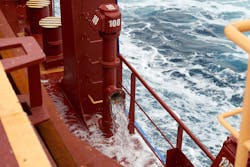EPA releases proposal concerning discharges of marine vessels
The U.S. Environmental Protection Agency (EPA) recently proposed standards to reduce the environmental impact of discharges, such as ballast water, that are incidental to the normal operation of commercial vessels. When finalized, EPA officials say, this new rule will streamline the current patchwork of federal, state and local requirements that apply to the commercial vessel community and better protect our nation’s marine waters.
“This proposal marks an important milestone in the Trump Administration’s efforts to better protect marine ecosystems while supporting commercial marine vessels,” said EPA Administrator Andrew Wheeler. “When combined with current, robust EPA initiatives to protect marine waters — including the Great Lakes Restoration Initiative, Chesapeake Bay Program, and National Estuary Program — our nation’s waters will be better able to support local recreation and the national economy.”
EPA is proposing to establish national standards of performance for incidental discharges from commercial vessels as required under the Vessel Incidental Discharge Act (VIDA). The proposed rule includes discharge-specific standards for 20 different types of vessel equipment and treatment systems, as well as general performance standards that would apply more broadly to the full range of incidental discharges.
EPA’s proposed standards would apply to:
Commercial vessels greater than 79 feet in length.
Other non-recreational, non-Armed Forces vessels, such as research and emergency rescue vessels.
Ballast water only from small vessels (vessels less than 79 feet in length) and fishing vessels of all sizes.
The proposed rule also outlines procedures for states working through EPA or the U.S. Coast Guard to seek more stringent requirements, request emergency orders or apply for no-discharge zones for one or more of the incidental discharges in any or all state waters.
EPA will accept comment on the proposal for 30 days, following publication in the Federal Register. To learn more about the proposed standards and the VIDA, visit: https://www.epa.gov/vessels-marinas-and-ports/vessel-incidental-discharge-act-vida.
VIDA was signed into law in December 2018 and requires EPA to develop regulations establishing discharge standards for vessels that are at least as stringent as the discharge requirements established in EPA’s 2013 Vessel General Permit (VGP). However, the discharge standards do not become enforceable until after the U.S. Coast Guard (USCG) promulgates implementing regulations to ensure, monitor, and enforce vessel compliance with EPA’s discharge standards when finalized. Under VIDA, the USCG has two years to finalize its implementing regulations once the EPA standards are final.
